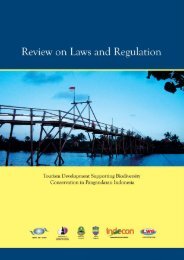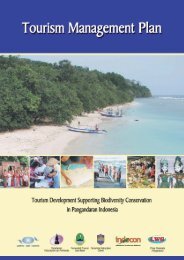Coral Reef Rehabilitation - unwto
Coral Reef Rehabilitation - unwto
Coral Reef Rehabilitation - unwto
- No tags were found...
Create successful ePaper yourself
Turn your PDF publications into a flip-book with our unique Google optimized e-Paper software.
Report on Artificial <strong>Coral</strong> <strong>Reef</strong> ConstructionReport on Artificial <strong>Coral</strong> <strong>Reef</strong> Construction3. The adopters sail offshore to implant the babycoral on the location. If they want and havelicence, adopters dive and implant it directly tothe artificial reef (with additional cost).4.5. Monitoring and EvaluationGrowth monitoring is an important step to ensurethe success of coral transplantation. It can alsoinform us about any situation which requiresimmediate action. Monitoring tools were developedas guideline to conduct monitoring activities. Bioecologicalparameters were compiled as monitoringmeasurement. They are as follows:minimum or according to the requirements. For theearly days after transplantation, monitoring shouldbe conducted every 2(two) weeks, because it is thecritical period for baby coral. Any dead fragmentsshould be replaced. After the first two weeks,monitoring should be conducted in the followingmonth, then every 3(three) months. Monitoringactivities are conducted by KMPP, LWG, and Indecon.Monitoring and observation were conducted onemonth after the first implant to get information oncoral growth and health. Healthy coral growth canbe mainly observed from its brownish color andis usually covered by mucus as its responds to theenvironment. The monitoring activity in December29, 2009 showed that 234 coral fragments grewwell and 23 fragments died. The death was causedby the size of baby coral being too small. They havebeen replaced by new baby corals. The adopters ofthe first transplantation batch in November 2008have received an Adopter Certificate and MonitoringReport. The template of the Monitoring Report isprovided at Annex 2.4.6. Community Awareness and ConservationEducationDissemination of coral transplantation programwere conducted through newsletter (the 3rd editionand the 5th edition); film (latest revision in March09); and flyers. It proved to be quite successful;considering many feedback from local communitythrough LWG and request from few hotels aboutfurther collaboration.Table 3. Bio-Ecological Indicators for Healthy <strong>Coral</strong>WaterTemperatureSalinitySunlightSedimentation<strong>Coral</strong>growthmeasurement<strong>Coral</strong>fragmentobservationMuccusobservationBioEcologicalIndicatorforHealthy<strong>Coral</strong>Optimumwatertemperaturerequirementforcoralgrowthis2530oC(Sukarnoetall.,1983).Watertemperatureinfluencesthecoralfeedingbehaviour.Mostcorallosstheirabilityincapturingtheirfoodintemperatureabove33,5 0 C,orbelow16 0 C(Mayor,1918). Sudden change of 4 6 0 C above and below threshold can causedeathtocoral.Hard coral is very sensitive to salinity change. Optimum salinity requirement forcoralgrowthisbetween30 0 / 00 35 0 / 00 .Freshwaterfromtheriverandrainfallcanchangethesalinity.Alga zooxanthella and most coral need sunlight and carbon dioxide to producehighenergy substances, thus providing an important dietary supplement(Nybaken, 1992). Without enough sunlight, the process will degrade and coralgrowthbecomesslow.Sedimentation that flows from land highly affects coral reef ecosystemdegradation. Sedimentation process caused by degradation of land ecosystem,suchasloggingthatleadstoerosion.Soilisbroughttoseathroughriverflowandcoatsthecoralreef.Claycoatingcoralreefwillenterdigestiveorganofpolypandmaycausedeath.Infiltrationofsedimentmayindirectlyhaltlightpenetrationtotheseabed,whichisrequiredbycoralreefforphotosynthesis.<strong>Coral</strong> health is measured by their height and volume in certain time. SomereferencesaidthatAcroporainhealthyenvironmentwillgrow35cmperyear.Itcanalsobemeasuredbyobservingtheadditionalpolypatacolony.Healthy coral will show their bright color. It depends on symbiotic process withAlgaeinthecoral.In certain condition coral produces muccus as a response to tolerableenvironmental pressure. In worse situation, slowly coral will release its pigment,becomepale,andmaydie.Particularly to evaluate the growth of transplantedcoral; regular meetings were held after eachmonitoring with KMPP to discuss. Monitoringactivities are conducted every 3(three) months at the~ 20 ~existence of figmen. The brown colour indicatesthe mutualism symbiosis with zooxanthella algae.Unhealthy coral growth is largely caused bysedimentation and temperature change; the coralImage 8. (from left to right) Michael Meyer’s Baby <strong>Coral</strong> at two-month old; Safrudin’s Baby <strong>Coral</strong>at two-month old; Safrudin’s Baby <strong>Coral</strong> at four-month oldImage 8. Snapshot of the 3rd Newsletter – Article about <strong>Coral</strong> <strong>Reef</strong> Transplantation~ 21 ~




